

<< Go Back up to Region ‘San Francisco Bay Area’
| Follow Mike Hume’s Historic Theatre Photography: |  |
 |
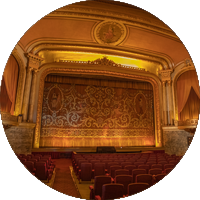
Architects: Reid Brothers
First Opened: 26th March 1926 (99 years ago)
Website: www.renaissancerialto.com 
Telephone: (510) 465-7586 
Address: 3200 Grand Avenue, Oakland, CA 94610 
The Grand Lake Theatre opened in March 1926 as a combination vaudeville and silent movie theatre. It has been dedicated to movies most of its life however the theatre’s vaudeville history remains preserved behind the projection screen. The theatre still operates today as a first-run movie theatre.

 Detailed Information
Detailed Information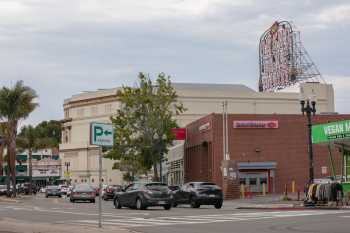
The Grand Lake opened in early March 1926 with The First Year (1926)  starring Matt Moore. The 1,700-seat theatre was built by local businessmen Abraham C. Karski and Louis Kaliski, and was designed by architects James W. Reid and Merritt J. Reid of San Francisco based architect firm Reid Brothers.
starring Matt Moore. The 1,700-seat theatre was built by local businessmen Abraham C. Karski and Louis Kaliski, and was designed by architects James W. Reid and Merritt J. Reid of San Francisco based architect firm Reid Brothers.
The theatre was designed in a Neoclassical style featuring Corinthian columns, monumental urns, and Classical frescoes and cornices. The auditorium side walls feature sumptuous drapes, and above is a large dome ceiling split in the early 1980s when the main auditorium was twinned.
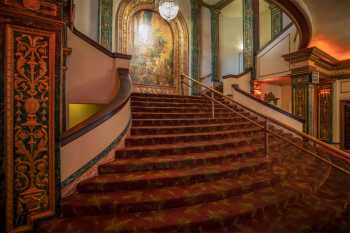
The theatre’s double height lobby also got a symmetrical and Neoclassical design, and theatre owner Allen Michaan has noted his intention to keep the lobby areas original rather than let them become filled with modern attractions such as video games.
Five months after opening, Karski & Kaliski leased the theatre to West Coast Theatres who would go on to become part of the Fox movie theatre empire. In later years the lease would be taken up by Mann Theatres  .
.
As the talkies took hold, vaudeville at the Grand Lake dwindled until eventually the theatre’s dressing rooms were no longer needed as part of the all-movie program. Today the backstage areas of the theatre are a time capsule, affording us a view into the past and the details of the nearly 100-year-old vaudeville stage arrangements.
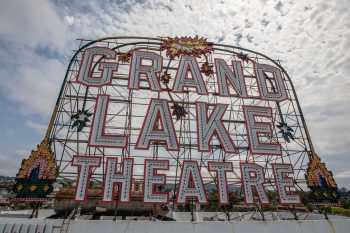
Atop the theatre building is a giant illuminated rooftop sign which was designed by Theodore Wetteland and built by Brumfield Electric Sign Co., Inc. According to theatre owner Allen Michaan the sign is the largest rotary contact incandescent light bulb sign in the world. It measures 72ft by 52ft (21.95m by 15.85m) and consists of 2,800 electric lamps. The sign has undergone significant recent restoration, and as of mid-2022 most of the sign has been converted to LED lamps underneath the thousands of original glass dome colored lamp covers. The original motor-driven mechanical switching gear, which makes parts of the sign flash and controls the chasing effects around the sign, has been retained in place and refurbished with replacement parts custom-made by hand where replacements no longer exist.
The theatre’s house curtain (main drape) is the center section of the main curtain originally installed in the San Francisco Fox Theatre, opened in 1928 and demolished in 1963.
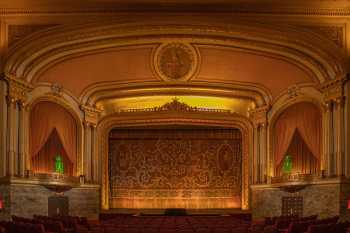
The theatre was originally equipped with a 3-manual, 11-rank Wurlitzer Style 235 theatre organ (opus 1182). The current installation is a 3-manual, 18-rank Wurlitzer organ, assembled in the early 1980s according to the American Theatre Organ Society (ATOS)  , and maintained by the NorCal Theatre Organ Society
, and maintained by the NorCal Theatre Organ Society  . Prior to the Covid pandemic the NorCal Theatre Organ Society arranged occasional weekend early morning organ concerts.
. Prior to the Covid pandemic the NorCal Theatre Organ Society arranged occasional weekend early morning organ concerts.
In 1980, Renaissance Rialto, Inc. took on the lease and spent $3.5 million renovating the theatre, which included twinning the main auditorium into two separate screens. Screen Two opened with 450 seats in the theatre’s old balcony on 19th June 1981.

In the mid-1980s, stores adjoining the theatre were converted into additional screens, connected to the main lobby by enclosing what had previously been an exterior alleyway. Screens Three and Four opened on 12th July 1995. Screen 3 features an Atmospheric design with an Egyptian theme, and Screen 4 features a Moorish Palace design.
The theatre suffered damage during the 1989 Loma Prieta earthquake. The now-disused DC generator located behind the theatre’s original Projection Booth sits in a half-on, half-off position on its pedestal base as a result of the earthquake. Other damage to the building was repaired before reopening.
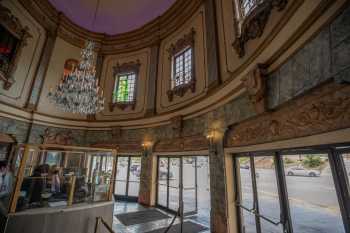
Prior to Karski & Kaliski’s 95-year lease (originally agreed in 1926) expiring, head of Renaissance Rialto, Inc. Allen Michaan purchased the theatre in August 2018. The purchase involved negotiation with nine descendants of the Kaliski and Karski families. Ray W. Kaliski, grandson of Louis Kaliski, said his family was happy the Grand Lake would continue to show films as it did as a silent movie house in the 1920s. “That’s one of the reasons why we were most interested in selling to Allen,” Kaliski said. “I think my grandfather, who was a theater man, would be pleased. Allen is the perfect choice to carry on the legacy of that building.”
Owner Michaan is noted for using part of the theatre’s marquee for liberal political messages, such as “This Is America — Every Vote Should Be Counted” during the Presidential election in the year 2000 .
As of mid-2022 the Grand Lake Theatre remains a popular first-run movie theatre in downtown Oakland. While currently all digital in the projection of movies, the Grand Lake retains the capability of exhibiting 35mm and 70mm films when needed. The Wurlitzer theatre organ is still played before Friday and Saturday evening shows in the main auditorium (Screen One).
 Videos from our YouTube channel:
Videos from our YouTube channel: Listed/Landmark Building Status
Listed/Landmark Building Status (14th July 1981)
(14th July 1981) Further Reading
Further Reading .
. .
. on the American Theatre Organ Society website.
on the American Theatre Organ Society website. , an interview by The Oaklandside
, an interview by The Oaklandside  with theatre owner Allen Michaan.
with theatre owner Allen Michaan. Photos of the Grand Lake Theatre
Photos of the Grand Lake TheatrePhotographs copyright © 2002-2025 Mike Hume / Historic Theatre Photos unless otherwise noted.
Text copyright © 2017-2025 Mike Hume / Historic Theatre Photos.
For photograph licensing and/or re-use contact us here  . See our Sharing Guidelines here
. See our Sharing Guidelines here  .
.
| Follow Mike Hume’s Historic Theatre Photography: |  |
 |